by Matthew Orwat | Nov 18, 2013
On the night of November 13th, a mild freeze of 30°F occured in parts of Northwest Florida. Don’t be caught without a citrus protection plan !
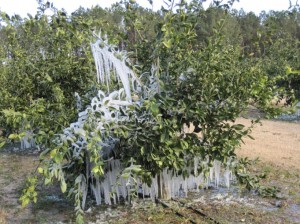
Satsuma Tree protected with micro-irrigation. Image Credit: UF IFAS Jackson County Extension
How cold does it have to get before citrus in Northwest Florida needs to be protected? A concrete answer to this question does not exist. Growers and home gardeners alike must consider several factors including type of citrus grown and the location of the citrus.
Below are a few quick facts to assist growers and home gardeners in determining whether to protect or not to protect their citrus:
- Certain citrus trees such as lime, pomelo, grapefruit, sweet orange, lemon and citron will definitely need protection or need to be moved into a sheltered area. Individuals that grow these types on a consistent basis either wrap their trees with protective covers each season or grow them in containers and move them into greenhouses.
- The meyer lemon, which is in reality a lemon-sweet orange hybrid, is a tree that was introduced to the united states in 1908. Mature dormant meyer lemons can be hardy down to 20°F, with fruit hardy to 26°F. Immature trees, or those that have not reached dormancy, should be protected. Covers made of cloth should be large enough to touch the ground so that heat from the soil can help keep the tree warm.
- Generally, satsuma are cold tolerant down to 15° F, but young trees or trees yet to achieve dormancy are usually only tolerant to 26°F. Fruit should not sustain damage from freezing temperatures above 25°F. Extreme winds sometimes make the effects of freeze events worse, so it is always better to err on the side of protection if the trees are planted in an exposed site.
- Kumquats are the most cold tolerant citrus type grown in Northwest Florida, so protection is not required unless freeze events reach 20°F.
Additional facts to assist the grower or home gardener with citrus protection:
- Plant trees on a south-facing slope, south of windbreaks, on the south side of a structure or under a light canopy if possible. South facing slopes block harmful cold winds. Structures offer radiant heat which aids in the protection of citrus trees. Additionally, light over-story pine canopies allow sufficient sunlight through while reducing frost damage.
- Wrap the trunk with commercial tree wrap or mound soil around the base of the tree up to 2 feet. This will protect the graft of the young tree. Thus, if the branches freeze the graft union will be protected.
- Cover the tree with a cloth sheet or blanket. For additional protection, large bulb Christmas lights can be placed around the branches of the tree. This will increase the temperature under the cover by several degrees. Be sure to use outdoor lights and outdoor extension cords to avoid the potential of fire.
- Water citrus trees. Well watered trees have increased cold hardiness. Do not over-water. If the ground is moist, it is not necessary to water.
- Frames may be installed around young trees to hold the cover. This option keeps the blanket or sheet from weighing down the branches.
- For large production areas, micro-irrigation is an option. This practice will protect citrus trees up to 5 feet, but must be running throughout the entire freeze event. For additional information read this publication on micro-sprinkler irrigation.
- Always remember to remove cold protection once the temperature rises so that the trees do not overheat.
- Do not cover trees with plastic tarp, these will not protect the tree and can “cook” the tree once the sun comes out.
For additional information, contact your local extension office.
by Larry Williams | Nov 18, 2013
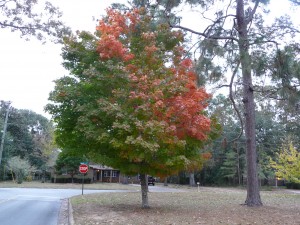
Florida maple beginning to exhibit fall color. Photo credit: Larry Williams
Although Florida is not known for the brilliant fall color enjoyed by some of our northern neighbors, we do have a number of trees that provide some fall color for our North Florida landscapes.
Our native flowering dogwood consistently provides some change in color before dropping its leaves. You can expect a red to maroon color in many of the dogwood leaves during fall.
Some of North Florida’s native maples produce good color each fall. Red maple provides brilliant red, orange and sometimes yellow leaves. The native Florida Maple, Acer saccharum var. floridum, displays a combination of bright yellow and orange color during fall. And there are many Japanese maples that provide striking fall color.
Another excellent native tree is Blackgum, Nyssa sylvatica. This tree is a little slow in its growth rate but can eventually grow to seventy-five feet in height. It deserves more use in our landscapes. It always provides a bright show of red to deep purple fall foliage.
Crape myrtle gives varying degrees of orange, red and yellow in its leaves before they fall. There are many cultivars – some that grow several feet to nearly thirty feet in height.
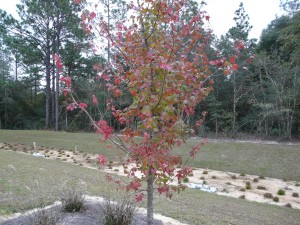
Young red maple with fall foliage. Photo credit: Larry Williams
There are a number of dependable oaks for fall color, too. Shumard, Nuttall and Turkey are a few to consider. These oaks have dark green deeply lobed leaves during summer turning vivid red to orange in fall. Turkey oak is sometimes referred to as “scrub” oak and is common on our deep sandy soils. It is short-lived as compared to most oak species, living for fifteen to thirty years before it starts to decline and die. It does not grow very large in height or trunk diameter and is not grown or sold much because it is so common in the wild. Nuttall and Shumard are becoming better available.
Sweetgum is another common native tree to considering for fall color. But some people dislike this tree because of the one to three-inch round fruit (called sweetgum balls) that it produces, which can be a nuisance as they fall on the ground around the tree. And this tree produces large surface roots that can be a problem for mowers, nearby curbs and sidewalks. But its star-shaped leaves turn bright red, purple, yellow or orange in fall.
Our native yellow poplar and hickories provide bright yellow fall foliage. And it’s difficult to find a more crisp yellow than fall ginkgo leaves.
These trees represent just a few choices for fall color. Including one or several of these trees in your landscape will allow you to enjoy the color of fall for many years right in your own backyard.
by Eddie Powell | Nov 18, 2013
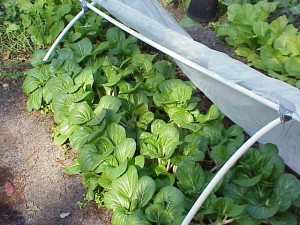
Image Credit : Eddie Powell
Northwest Florida homeowners enjoy growing their own vegetables every fall, but are faced with cold weather issues, especially during the first few days of December. For example, most cole crops can be planted until November, but they must be protected from the cold weather or they will need to be replaced. A good variety of cold tolerant plants should be used in order to prevent total devastation of the garden by extremely cold weather.
Below are a few tips to assist the home gardener in growing a successful winter vegetable crop.
- For tender plants, site selection should the top priority when preparing for a freeze. Vegetable plants need a site with good air drainage; not in a low area where cold air settles. Arranging tender plants along a barrier to protect them from cold winds improves the plants cold protection, especially from very hard freezes.
- Poorly drained soils result in weak and shallow roots which are more susceptible to cold injury.
- Plants grown with the correctly applied rate of nutrients will tolerate colder temperatures better and recover from cold injury faster than plants grown with little to no nutrients.
- Watering vegetable garden plants before a freeze can help protect plants. A well watered soil will absorb more solar radiation than dry soil and will radiate heat during the night. This may increase cold tolerance by as much as 2°F.
- Saturated soil conditions can damage the root systems of most plants over a few days, so make sure the ground is well-drained.
- Healthy vegetable plants are more resistant to cold than vegetable plants weakened by disease, insect damage, or nematode damage. Routine inspection for pests and implementation of necessary control measures are essential.
- Plastic or cloth coverings can help protect vegetable plants more from frost than from extreme cold. Covers that extend to the ground and are not in contact with the vegetable plants foliage will reduce cold injury. If the vegetable plant foliage is in contact with the cover it is often cold burned or injured because of heat transfer from the foliage to the colder cover. Some examples of excellent plant covers are cloth sheets, quilts or black plastic. If plastic covering is used, it is extremely important to remove the covering during the day to provide for ventilation of trapped heat.
- Feel free to contact your local county extension office for information on cold protection, pest identification and recommended control measures.
by Taylor Vandiver | Nov 11, 2013
As I made a visit back to my hometown in North Alabama I was reminded of the subtle changes from fall into winter, which are not always apparent to me living in Tallahassee: the vibrant palette of leaves as they make their permanent descent until spring, the litter of spent cotton along each highway and county road and the annual pecan harvest that has been a tradition in my family for as long as I can remember.
Due to the variations in climate and topography from upper Alabama to the panhandle of Florida, our seasons can differ greatly. However, I know of one entity that remains a constant and that is the availability of pecans. Pecan trees (Carya illinoinensis) are a common sight throughout the South. They can be spotted as far west as Texas and as far north as Illinois. The pecan tree is native to the Mississippi floodplain, which has deep, fertile, well-drained soils. Before the arrival of Europeans, Native Americans used pecans as a primary food source for thousands of years.
What’s more, pecans have major economic value. The annual value of pecans in the United States is estimated at 200 to 500 million dollars. Florida produces from five to ten million pounds of pecans annually. The majority of that pecan production acreage (6,500 acres) can be found in North Florida. While the nut is the main attractant of the tree, there’s not much that warms the heart more than seeing pecan pie at the dessert table on Thanksgiving.
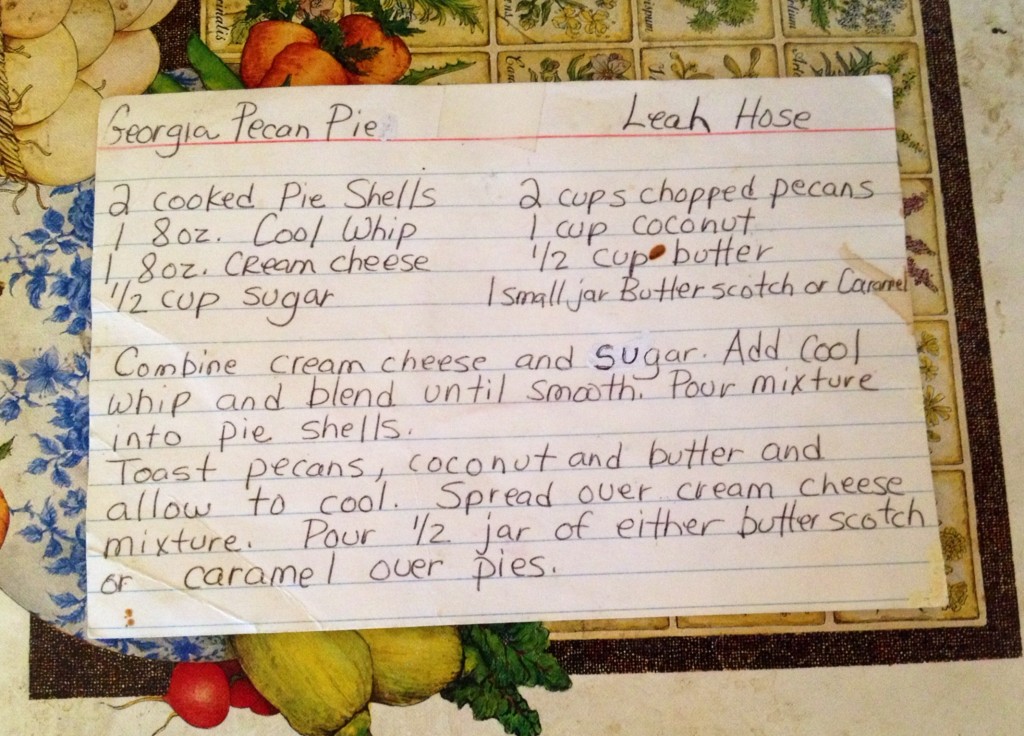
A well worn recipe for southern pecan pie that has been passed down through my family.
Pecan trees are deciduous, which means that they drop their leaves in the winter. An additional consideration for those planning to install pecan trees is to be aware that they are wind-pollinated and that their male and female flowers often do not mature at the same time. Therefore, in order to ensure the possibility of high yields, two or more cultivars should be planted together for cross-pollination.
Be sure to choose a variety like ‘Elliot’ or ‘Curtis’ that has good disease resistance, is suited for North Florida and will cross-pollinate well. Plant pecans during the colder months to allow for root growth before spring. The optimum soil pH for pecans is 5.5 to 6.5. At the lower end of this range, micronutrient deficiency symptoms should be less common. Pecan trees should start producing decent crops in six to twelve years. A tree at maturity can reach up to seventy feet tall so plan spacing and placement accordingly.
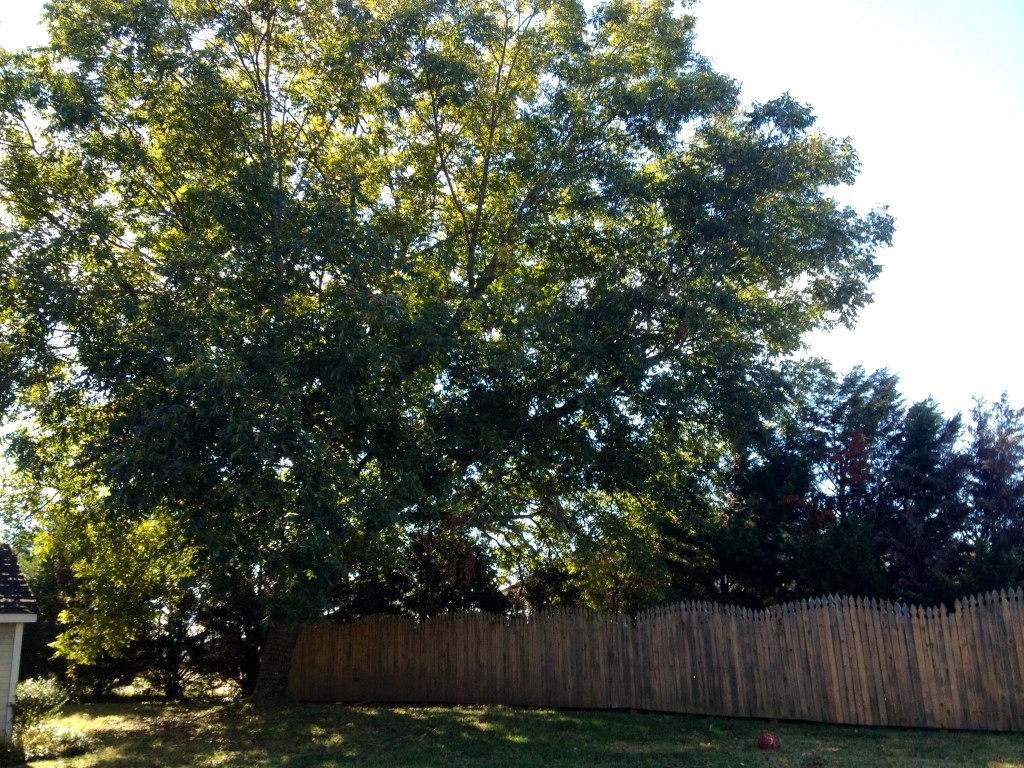
Pecan tree planted by my great-grandparents in Monrovia, Alabama.
For more information please consult Pecan Cultivars for North Florida or contact your local UF IFAS county extension office.
by Beth Bolles | Nov 11, 2013
Fall color in the Florida landscape may be a little different than more northern areas but it is just as dramatic with the right plant selections. One of the favorite perennials that is in peak bloom right now is the Cassia or butterfly plant, Cassia bicapsularis. Grown for its showy bright yellow flowers, this soft-wooded perennial can be a garden accent when grown as a small tree. Plants normally grows as a multi-stemmed plant with a vase shape or rounded canopy. Size ranges from 5-10 feet in height and the best flowering is when plants receive full sun.
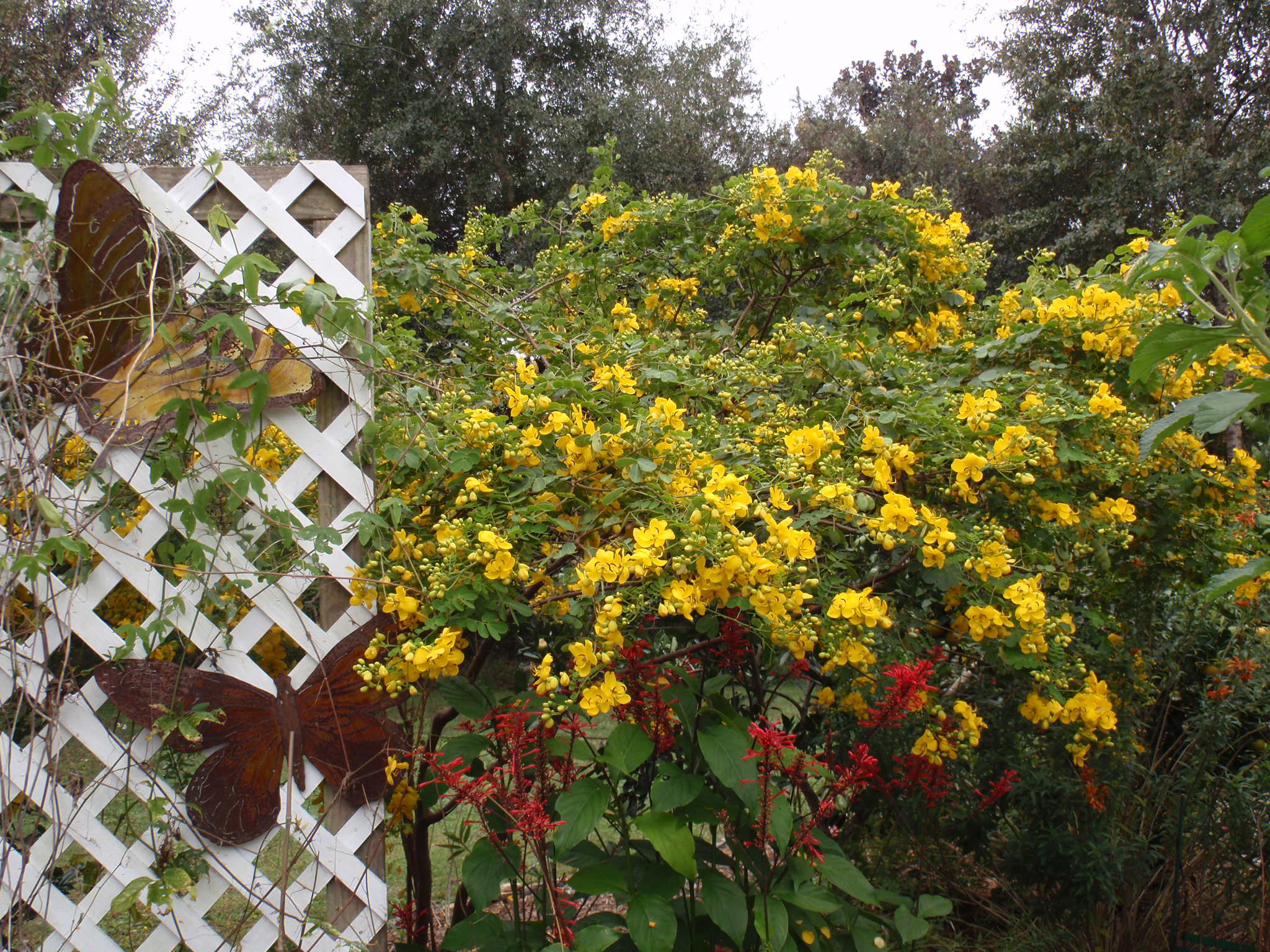
An added benefit of this species of cassia is that it can serve as a host for sulfur butterflies. Blooms will often last until first frost and plants may be injured by freezing temperatures. Homeowners will cut back cold damaged stems and wait for regrowth in the spring. During the growing season, larger plants may need support and summer storms can break some branches. Despite these issues, the fall flower show makes this a highlight in a garden. Learn more about this cassia from the University of Florida IFAS Extension.







